Birdfinding.info ⇒ A localized Cuban endemic that is readily found in and around Ciénaga de Zapata National Park. Sites where it is usually present include Santo Tomás, La Turba, and Bermejas.
Red-shouldered Blackbird
Agelaius assimilis
Endemic to Cuba, where it is locally common in the Zapata Swamp region, with three or four additional small populations scattered across the western half of the island: on the Guanahacabibes Peninsula; northern Matanzas (Cárdenas); and along the southern coast, east of Trinidad. Also known from a few sites on Isla de la Juventud.
Strongly associated with marshes and swamps, especially when breeding. Also forages in other open habitats near breeding areas.
Identification
Adult male is essentially identical to the male Red-winged Blackbird, though it is slightly smaller and differs in behavior and voice. When fully exposed, the shoulder patch has a wider buffy border than on a typical Red-winged.
The female Red-shouldered is all-black, unlike the females of related species.
Immature males may have brownish shoulder patches, and are potentially confused with Tawny-shouldered Blackbird.
Individuals with ambiguous or concealed shoulder patches can be identified through other factors: habitat, voice, and structure. (See below.)
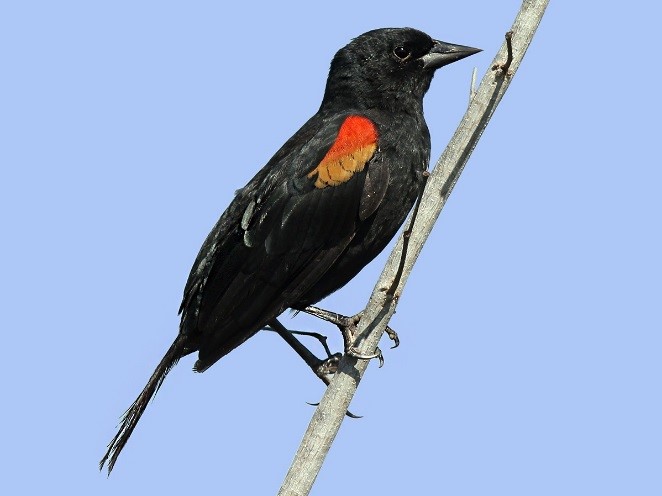
Red-shouldered Blackbird, male. (Cienagüita, Cienfuegos, Cuba; September 25, 2015.) © Arturo Kirkconnell Jr.
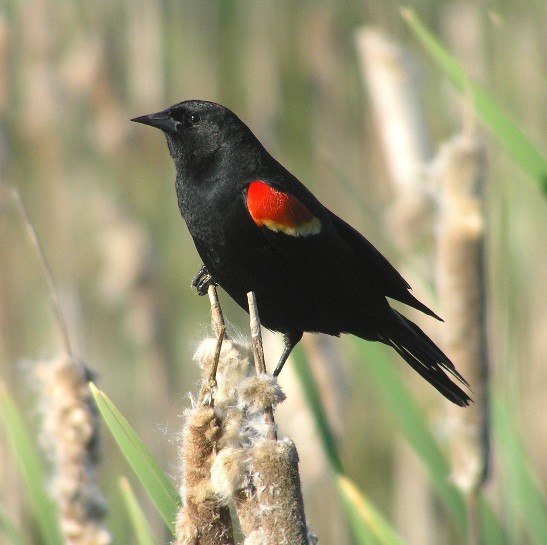
Red-shouldered Blackbird, male. © W. Siegmund

Red-shouldered Blackbird, male. (Matanzas, Cuba; January 1, 2017.) © Kent Fiala
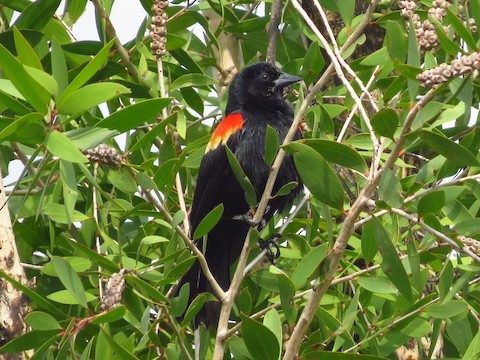
Red-shouldered Blackbird, male. (Cienagüita, Cienfuegos, Cuba; September 25, 2015.) © Arturo Kirkconnell Jr.
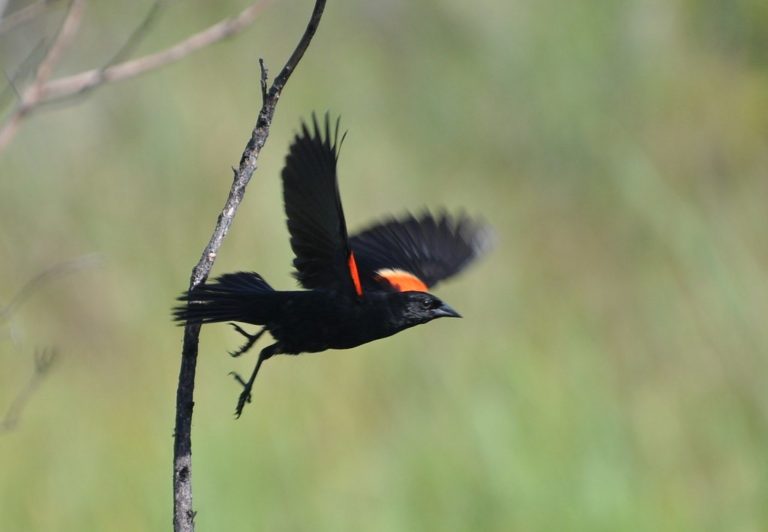
Red-shouldered Blackbird, male. (Guama, Matanzas, Cuba; July 22, 2011.) © Karl-Heinz Dohlich

Red-shouldered Blackbird, male. (Matanzas, Cuba; December 1, 2014.) © Dubi Shapiro
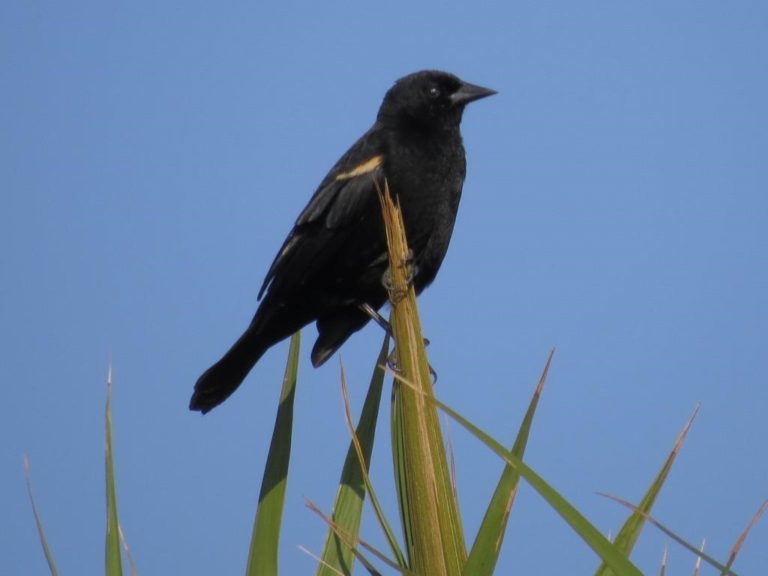
Red-shouldered Blackbird, male showing only the buffy edge of epaulet. (Cienagüita, Cienfuegos, Cuba; February 18, 2017.) © Colin D. Jones
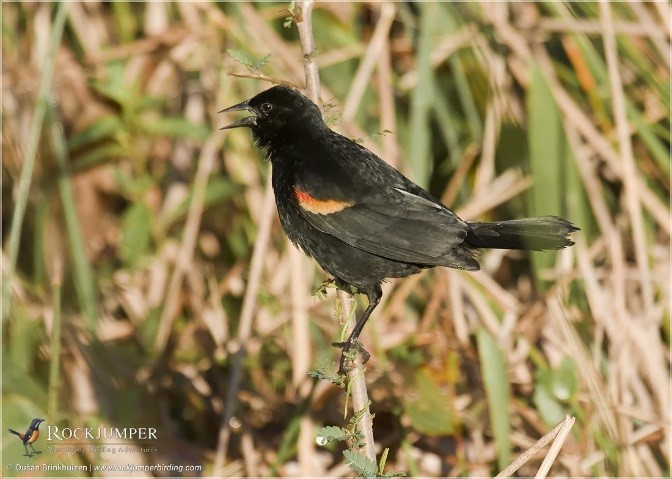
Red-shouldered Blackbird, male showing mainly the buffy edge of epaulet. (La Cuchilla, Matanzas, Cuba; February 19, 2017.) © Dušan M. Brinkhuizen

Red-shouldered Blackbird, male. (Zapata Peninsula, Matanzas, Cuba; August 6, 2014.) © Greg Griffith
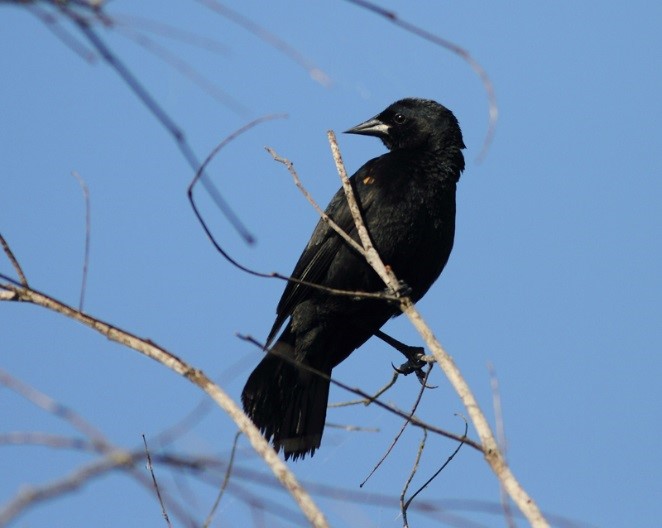
Red-shouldered Blackbird, male with epaulet almost completely concealed. (La Turba, Matanzas, Cuba; May 6, 2013.) © William Price
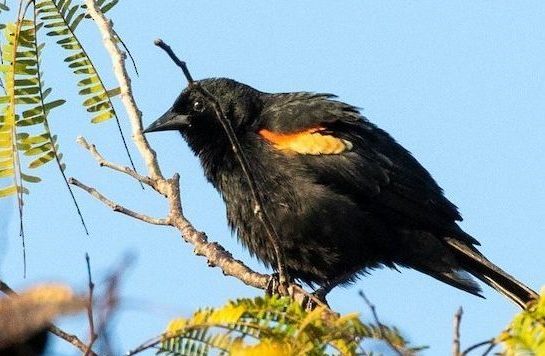
Red-shouldered Blackbird, male showing mainly the buffy edge of epaulet. (La Cuchilla, Matanzas, Cuba; January 15, 2016.) © Mel Senac
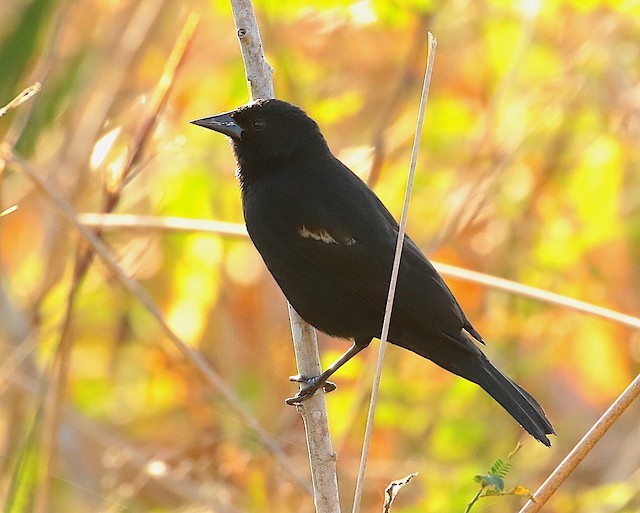
Red-shouldered Blackbird, male showing only the buffy edge of the epaulet. (La Turba, Matanzas, Cuba; February 23, 2018.) © Arco Huang
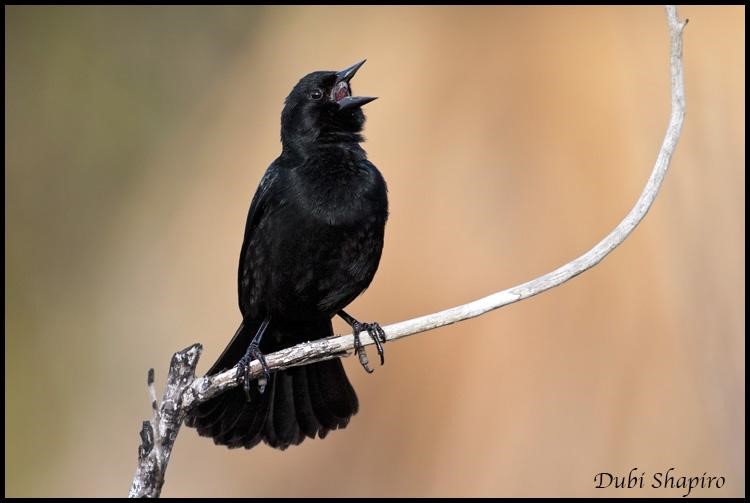
Red-shouldered Blackbird, female singing. (Matanzas, Cuba; December 1, 2014.) © Dubi Shapiro
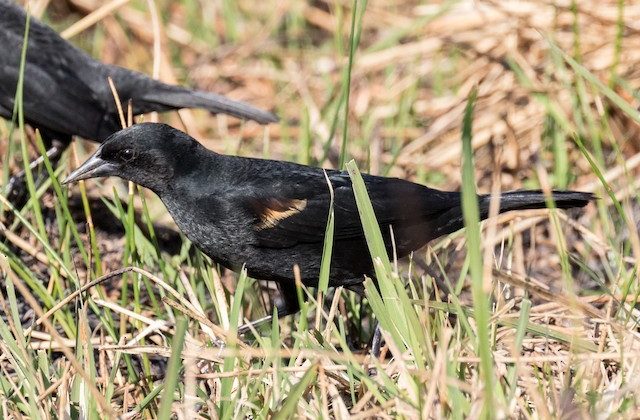
Red-shouldered Blackbird, male showing only the buffy edge of epaulet. (Matanzas, Cuba; March 19, 2017.) © R. Dennis Ringer
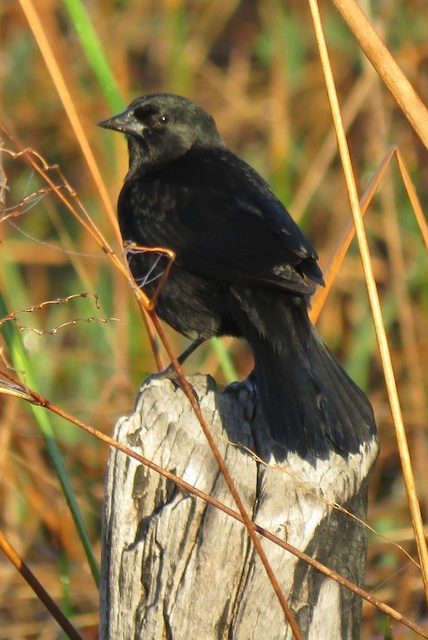
Red-shouldered Blackbird, female. (Bermejas, Matanzas, Cuba; February 5, 2018.) © Eric Weir
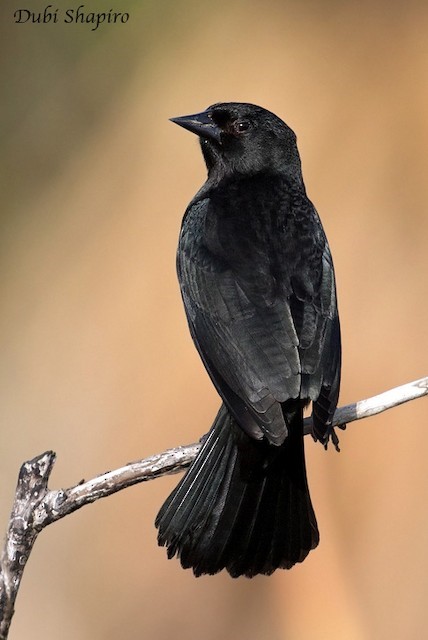
Red-shouldered Blackbird, female. (Matanzas, Cuba; December 1, 2014.) © Dubi Shapiro
Voice. Song is a creaky but musical trill that seems to burst out of the bird. Both sexes have the same song and pairs often duet: first one sings, then the other immediately echoes. Common call is an abrupt chuck!:
Cf. Tawny-shouldered Blackbird. Tawny-shouldered Blackbird occurs throughout Red-shouldered’s range. Although the colors of the epaulets are usually sufficient to identify these species, the epaulets are often concealed and both have a pale lower edge that is often the only visible part. In addition, the immature male Red-shouldered can have a brownish epaulet, thus resembling Tawny-shouldered. Even among adults of these species, there is enough color variation to create confusion: Red-shouldered’s epaulet can sometimes appear burnt-orange, and Tawny shouldered’s can appear reddish.
Other factors that can be useful to identify ambiguous Cuban blackbirds include:
Habitat: A strong initial indicator, as Red-shouldered rarely wanders far from marshes, whereas Tawny-shouldered is largely arboreal and favors woodland edges. However, these preferences are not absolute, and both species are at times found in fields and trees.
Voice: Most of Tawny-shouldered’s calls are metallic and high-pitched, whereas Red-shouldered’s common contact call is a much deeper chuck!
Female Plumage: These are social birds that are usually encountered in flocks, so it is often possible to them based on multiple individuals. In Tawny-shouldered, the sexes are similar, whereas the female Red-shouldered is all-black.
Bill Shape: On average, Tawny-shouldered has a shorter bill than Red-shouldered. This can be hard to judge in isolation, but it is useful when an otherwise dubious individual shows a long, thin bill, confirming that it is not Tawny-shouldered.
Cf. Red-winged Blackbird. Surprisingly, there appear to be no published records of Red-winged Blackbird in Cuba, although as an abundant migratory species it seemingly must occur there as a vagrant from time to time. Any record of a male would have to be carefully documented because of its close similarity to the male Red-shouldered.
The epaulets of the two species are similar but not identical. Comparing the two in full flush, Red-shouldered’s epaulet is more orange overall: the red has a paler, more orange tone (Red-winged’s is more scarlet), and the lower margin often appears orange (Red-winged’s is usually paler). However, such subtle differences in coloration are subject to lighting, feather-wear, and individual variation. A more objective difference for review of photographs is that the pale margin on Red-shouldered is consistently broader than the margin on Red-winged.
Cf. Shiny Cowbird. Female Red-shouldered Blackbird is about the same size, shape, and color as a male Shiny Cowbird. Their habits and preferred habitats differ, but at times they may occur in the same mixed flocks. The cowbird usually appears much glossier, and has a somewhat shorter bill—although their bills are otherwise similar in shape. In addition to its longer, thinner bill, the blackbird has a broader tail with a distinctively ragged tip.
Notes
Monotypic species. Formerly considered a subspecies of Red-winged Blackbird.
References
Barker, F.K., A.J. Vandergon, and S.M. Lanyon. 2008. Species Status of the Red-Shouldered Blackbird (Agelaius assimilis): Implications for Ecological, Morphological, and Behavioral Evolution in AGELAIUS. The Auk 125:87-94.
eBird. 2018. eBird: An online database of bird distribution and abundance. Cornell Lab of Ornithology, Ithaca, N.Y. http://www.ebird.org. (Accessed October 23, 2018.)
Garrido, O.H, and A. Kirkconnell. 2000. Field Guide to the Birds of Cuba. Cornell University Press, Ithaca, N.Y.
Jaramillo, A., and P. Burke. 1999. New World Blackbirds: The Icterids. Princeton University Press, Princeton, N.J.
Navarro, N. 2015. Field Guide to the Endemic Birds of Cuba. Ediciones Nuevos Mundos, St. Augustine, Florida.
Raffaele, H., J. Wiley, O. Garrido, A. Keith, and J. Raffaele. 1998. A Guide to the Birds of the West Indies. Princeton University Press, Princeton, N.J.
